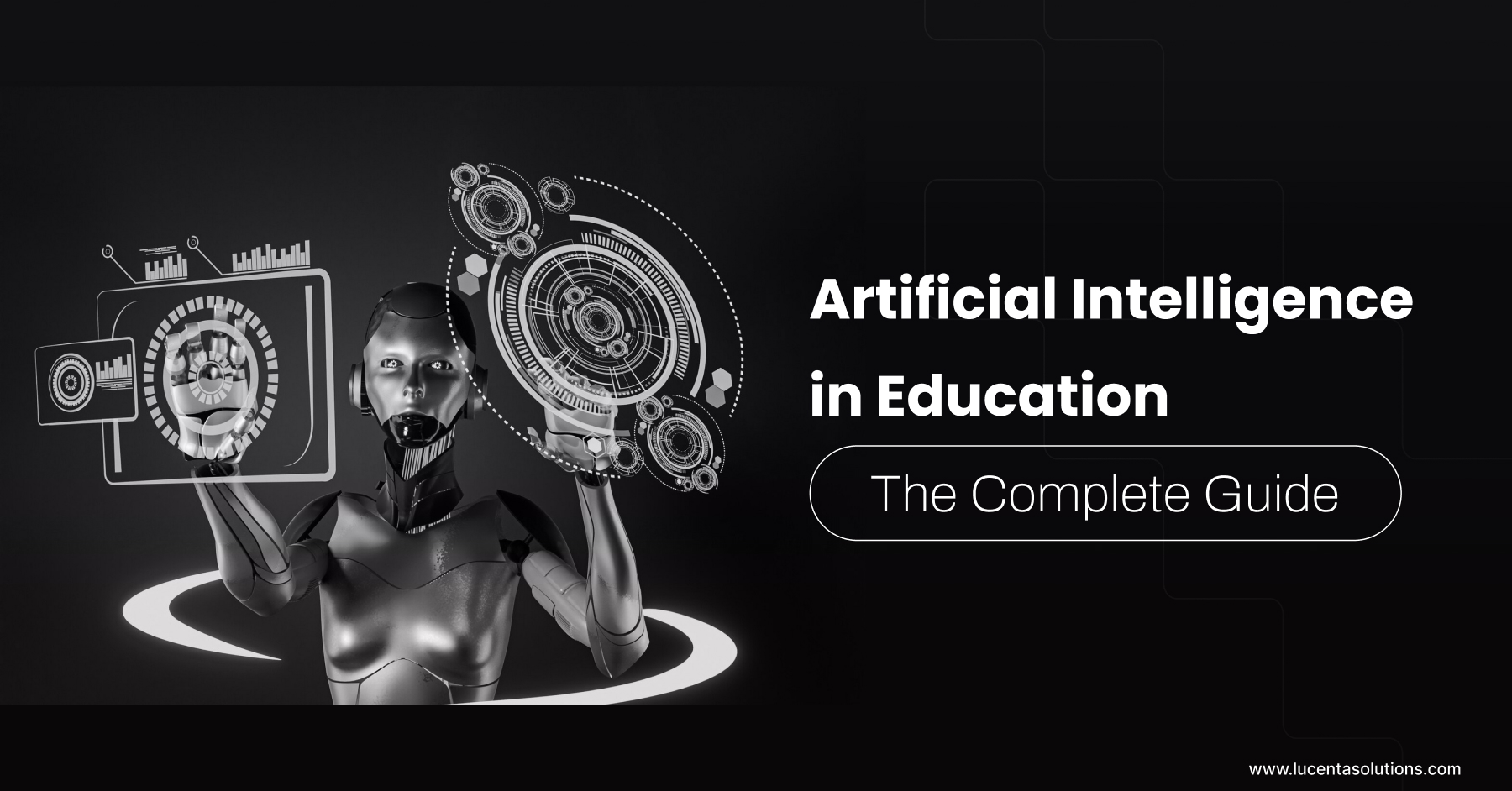Artificial Intelligence in Education: The Complete Guide
In the market for artificial intelligence in higher education, creating adaptive learning environments enhances the teacher and student learning process. Artificial intelligence (AI) technologies like machine learning, deep learning, and natural language processing (NLP) are being progressively integrated into training and educational software to improve learning outcomes and user experience.
When integrating artificial intelligence (AI) into educational systems to enhance information transmission and evaluation, current educational paradigms are being followed.
The demand for Artificial Intelligence Applications in education can be viewed in terms of its market size. The market for artificial intelligence in education is expected to increase from its estimated $2.5 billion in 2022 to $88.2 billion by 2032, with a compound annual growth rate (CAGR) of 43.3%. Other artificial intelligence in education statistics define the changing face of the industry.
With technology upgrading, the demand for AI for education is also increasing. This article gives you insight into how the use of artificial intelligence in education is rapidly changing the industry.
What is Artificial Intelligence in Education?
How about imagining a future where students get complete access to the syllabus without having to invest in books, personalized support from teachers, and inclusive learning opportunities? All these are possible with the inclusion of AI in education.
Artificial intelligence applications in education involve the integration of intelligent systems and technology for personalized instruction and improved learning experiences. Schools and universities are now switching to adaptive learning platforms, virtual tutors, and predictive analytics, which help customize the curriculum to each student’s needs and provide immediate feedback.
The International Journal of Artificial Intelligence in Education publishes an overview of AI in education. This will help one understand AI concepts and techniques since they involve modeling and representing pertinent knowledge, either before or during execution.
The main aim of investing artificial intelligence in higher education is to offer a better learning and teaching environment. The World Economic Forum’s Education 4.0 Framework, released in 2020, outlined eight critical changes to improve educational quality in the era of the Fourth Industrial Revolution.
How is Artificial Intelligence used in Education?
There are different ways in which AI can be used in education. Moreover, with the implementation of Education 4.0, AI has the power to shape the system in various ways. Some of these are-
Can take up the Teachers’ Roles
According to a report by UNESCO, there will be a need for around 44 million primary and secondary teachers globally by the end of 2030. The demand for teaching methods, whether online or offline, is increasing. The lack of teachers worldwide presents a significant obstacle to raising student achievement, as the demand for teachers is expected to soar in the years to come. By streamlining administrative duties, AI integration in education can free up teachers’ time for more purposeful student interaction.
The institute can foster an atmosphere where educators flourish and produce a more engaging learning experience by automating repetitive tasks and placing a solid emphasis on human-centric teaching. However, teaching is more than just passing along knowledge; AI should support teachers rather than take their place.
By Supporting Translation and Language Learning
The most obvious uses of AI in education are for language acquisition and translation. In addition to being a proficient translator, ChatGPT architecture may be used as a tool for language learning, offering students grammar and vocabulary instruction as well as support with work checking. Many students who are keen to learn foreign languages can use AI as a part of their study methods. AI for education is designed to help teachers and learners learn translation and language.
Helping with Early Education
One significant use of AI in education is in early childhood. AI can be used to develop interactive games and other educational resources that help young children learn social or academic abilities.
Monitoring systems that follow children’s behavior to provide insights into their development can also be powered by artificial intelligence. When the teacher is busy, it can serve as an assistant by attending to the students. AI has been demonstrated in several studies to enhance early childhood education instruction and learning, particularly language development.
AI in Teaching
Teaching does not seem to be one of the jobs that AI will threaten, at least not in the K–12 sector. However, AI has significantly influenced the teaching method.
The epidemic demonstrated the importance of in-person instruction, and schools also help students with socialization and other aspects of learning. Nonetheless, teachers can gain a lot from AI technologies, including time savings and the ability to focus their energies on more worthwhile projects.
AI tools like ChatGPT can aid with a variety of tasks, such as lesson planning, providing students with individualized support, and even turning textbooks into movies.
To Personalize Learning Content
Individual tutoring improves learning outcomes, with students routinely exceeding 98% of their classmates in typical classroom settings. On the other hand, offering each student customized tutoring is a significant financial obstacle.
AI provides a way to overcome this obstacle. With the use of AI, teachers and education heads can now customize the educational process for each student, improving academic results and efficiently meeting a range of learning requirements. Customized interfaces prove to be quite helpful, especially for kids who are neurodiverse or have varying physical abilities.
Automated Systems for Grading and Feedback
Artificial intelligence can free up educators’ time in interaction with students by automating tasks like grading and administrative work. This is a typical use of AI in education.
Benefits of Artificial Intelligence in Education
Artificial intelligence can help education in many ways, from using it to changing the overall method of teaching. Let’s examine some of the benefits of artificial intelligence in education with examples.
Creating AI-Powered Textbooks
One benefit of using artificial intelligence in education is creating AI-powered textbooks. The South Korean Ministry of Education has set a goal of introducing this learning system for students by 2025. Artificial Intelligence can generate tailored learning experiences, allowing students to progress at their speed.
The curriculum will first include math, English, and informatics before eventually covering every subject on the list. The Ministry has placed a strong emphasis on using AI support in conjunction with human teachers.
AI can evaluate each student’s proficiency and then provide learning materials specifically tailored to their needs.
Universal Access to Students
With the availability of artificial intelligence applications in education, students and teachers can both benefit in the long term. Using tools and applications can ensure that everyone can participate in classrooms, even those with visual or hearing disabilities or those who speak other languages.
A free PowerPoint add-on called Presentation Translator generates subtitles for lectures in real time. Additionally, this creates opportunities for kids who might be sick and unable to attend class or who need to learn a subject that needs to be taught in their school at a different level. AI can assist in changing the traditional grade level into modern methods.
Automate Administrative Work
Grading assignments and tests take a lot of time. Artificial Intelligence (AI) can efficiently handle these jobs and simultaneously provide suggestions for bridging knowledge gaps. While machines are currently capable of grading multiple-choice exams, they are almost ready to evaluate written responses. AI helps free up teachers’ time spent on single students or any administrative work. AI has many promises to improve the efficiency of the admissions and enrollment processes.
AI Making Teaching Inclusive
According to UNICEF, there are more than 240 million children with disabilities. A significant proportion of them lack educational support, accessible technologies, or learning resources. To overcome this, UNICEF is now using AI to create digital textbooks (as mentioned earlier) that are appropriate for a wide range of learners. The textbooks’ functionality, which includes text-to-speech conversion, audio descriptions, and sign-language films, allows the curriculum to be tailored to the needs of individual students.
Smart Content Creation
One of the most effective uses of AI in education is content generation. With the aid of this cutting-edge technology, educators and researchers may produce intelligent content for easy teaching and learning. One example is the visual representation of the content. Artificial Intelligence (AI) smart content production increases the real-life experience of visualized web-based study environments when traditional education approaches can only present lab tryouts as visual elements. With 2D and 3D visualization, where kids perceive information differently, technology helps.
Future Trends of Artificial Intelligence in Education
The application of artificial intelligence in education is changing the overall face of the industry. Considering the current growth, the future trend looks promising. Some of these are-
Curriculum Design with Generative AI
Generative AI is disrupting the time-consuming process of developing curriculums. It takes in enormous volumes of instructional resources and curriculum content. For analysis, deep learning networks collect information from lesson plans, assessments, quizzes, and textbooks.
Data Analytics
Artificial intelligence (AI) systems will keep improving in assessing educational data and producing insights that teachers can use. This will make individualized instruction and data-driven decision-making possible.
The Use of AR and VR Technologies
These resources make abstract ideas come to life, resulting in immersive learning experiences. While virtual reality (VR) delivers a fully immersive experience in a simulated environment, augmented reality (AR) technology overlays digital content over the user’s natural surroundings.
Conclusion
According to the Shaping the Future of Learning 2024 report from the World Economic Forum, incorporating AI into education has the potential to enhance students’ learning outcomes and experiences. The report also highlights how important it is to scale AI literacy to prepare students for all kinds of future employment.
Moreover, education companies investing in artificial intelligence applications in education, like- Immersive Learning, Automation, data-driven results, and others, can change the method of learning and teaching.




